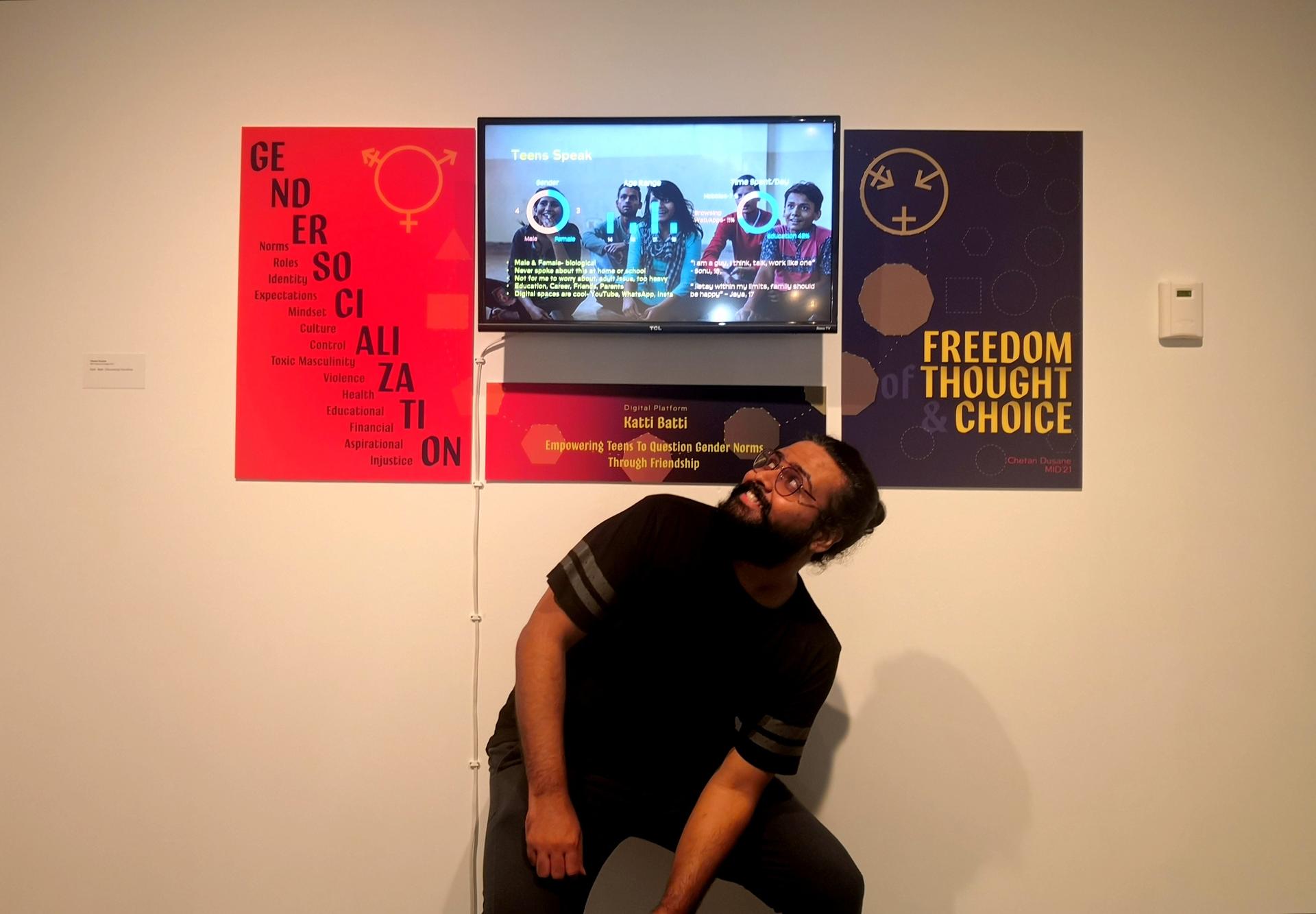Image
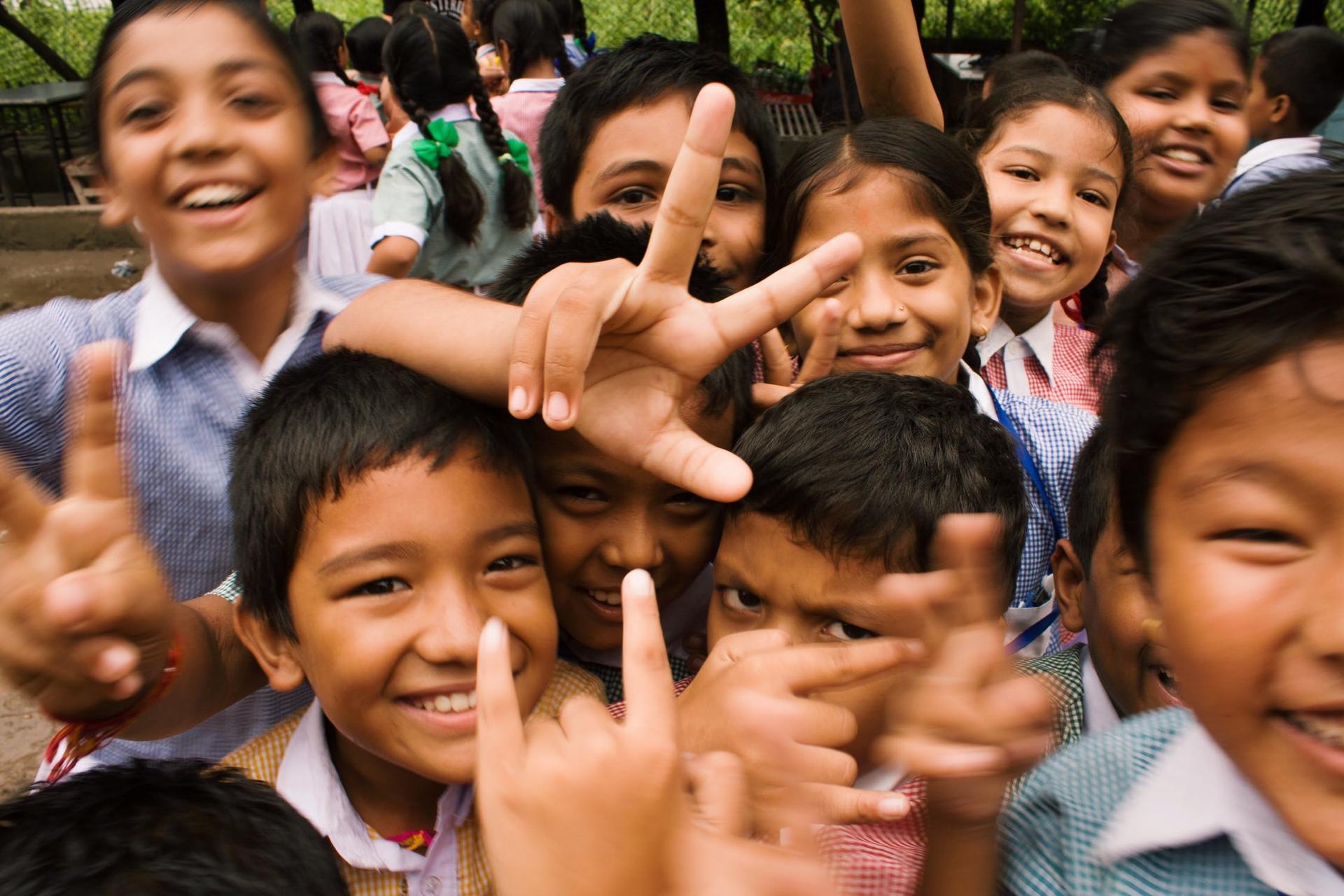
Katti Batti
A Digital Tool for Young Adolescents to
Transgress the Limitations of Gender Socialization
through Empathy and Friendship
ABSTRACT
The genesis of this project lies in the personal experiences that led me to believe that the culturally learned and perceived gender roles, norms, and expectations limit a person’s health, educational, professional, economic, and social abilities.
The work began by finding the evidence connecting the learned, perceived gender roles, norms, and allied cultural expectations to the ability to think freely. The research revealed the limiting effects of gender roles and norms on self-identity, personal belief systems, and a place’s culture. The study further led to uncovering the link between limiting personal belief systems and cultural environment to the lack of openness of a person to receive new knowledge and ideas. This lack of openness was then identified to impair an individual’s decision-making ability, which ultimately negatively affects the ability to self-actualize.
Gender Socialization was identified as a fundamental process that leads to the exposure, development, adoption, and conformity to the limiting gender roles, norms, stereotypes, and expectations.
Research and expert consultations led to identifying continuous consciousness-raising about gender socialization and stereotype conformity as an efficacious strategy to break the gendered lenses. The early adolescence (12-15 yr.) age group was identified as a window of opportunity to mitigate the effects of gender socialization because of the physical, cognitive, and behavioral changes that occur at this age.
In response to this opportunity, initial concept development, prototyping, and testing of a digital tool intended to evoke thought on the topic were accomplished. The tool is designed with the intention to make a complex subject matter accessible and relatable to young adolescents. The goal is to help them reflect on their own biases and gradually become aware of the effects of gender socialization on their choices and decision-making. The emotions of friendship and empathy are used as vehicles to highlight the significance of breaking deeply gendered outlooks.
Image

Research Questions
1. What is the relationship between learned gender roles self-identity, and our perception of our own capabilities?
2. In what ways do learned gender roles and norms affect our ability to think freely and openness for new ideas?
3. Do the learned gender roles and norms limit our personal and collective decision-making and the ability to self-actualize?
Hypothesis
Image
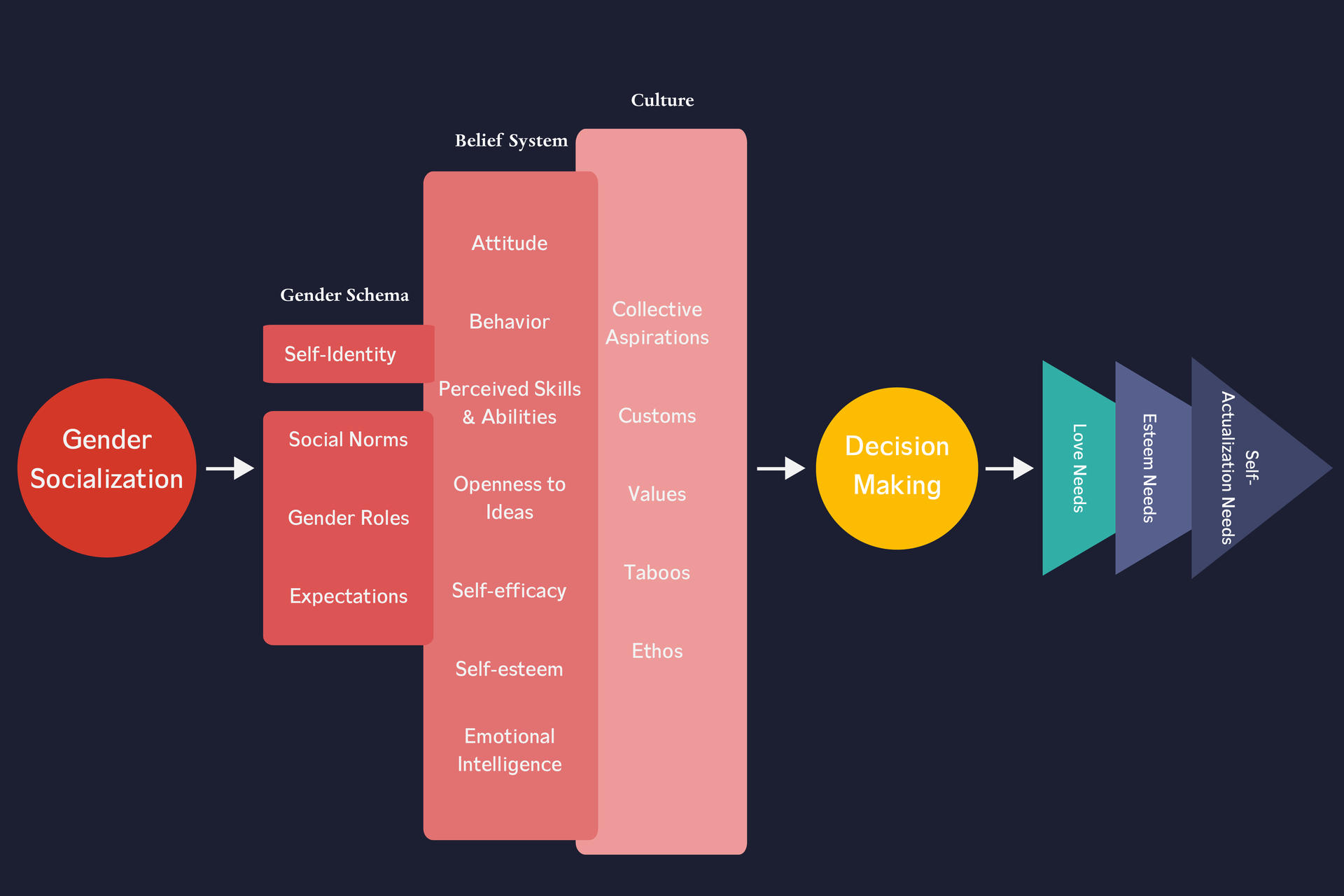
The literature helped discover the critical influence the process of gender socialization has on individuals’ sense of identity and sense of self. If a country’s culturally- and socially enforced gender roles are too rigid/binary/limiting/constricting, or if the risk of transgression is too severe, this can profoundly impact individuals’-men, women, and non-binary/genderfluid individual's ability to self-actualize.
The literature revealed the existence of a strong limiting effect of gender socialization on self-actualization. An understanding of the mechanics of the gender socialization process was also built. With this knowledge, a hypothesis was developed shown in the adjacent image.
The attempt here is to encompass and connect all the relevant factors that significantly support the suppressive process of gender socialization to limit an individual’s
capability to self-actualize. The overarching intention is to convey that the process of gender socialization develops the gender schema of an individual, which then builds up an individual’s belief system. The belief system is seen here as an extension of the schema. The belief system of the individual and that of the others in the community come together to form the culture of a place. This culture profoundly shapes collective and individual decision-making; and with this shaping-power comes the ability to severely limit the love (relationships), esteem (identity), and self-actualization needs of individuals.
Hence, the hypothesis provided a solid reason to consider the process of gender socialization as a potential action space.
Response
Design for;
1. Consciousness Raising
Aid impressionable young adolescents (12-15 yr.) to be conscious about the ill, limiting effects of gender socialization,
2. Constant Engagement + Resources
Engage young adolescents continuously in the process of building consciousness and resources to mitigate the effects of gender socialization
3. Engaging
Make the engagement efforts and resources accessible, age-appropriate and fun
Approach
An online tool based on
Scenario-Choices-Questions approach through Friendship & Empathy
To help young adolescents;
See, Realize, Relate and Question Gender Socialization and its outcomes...
Image
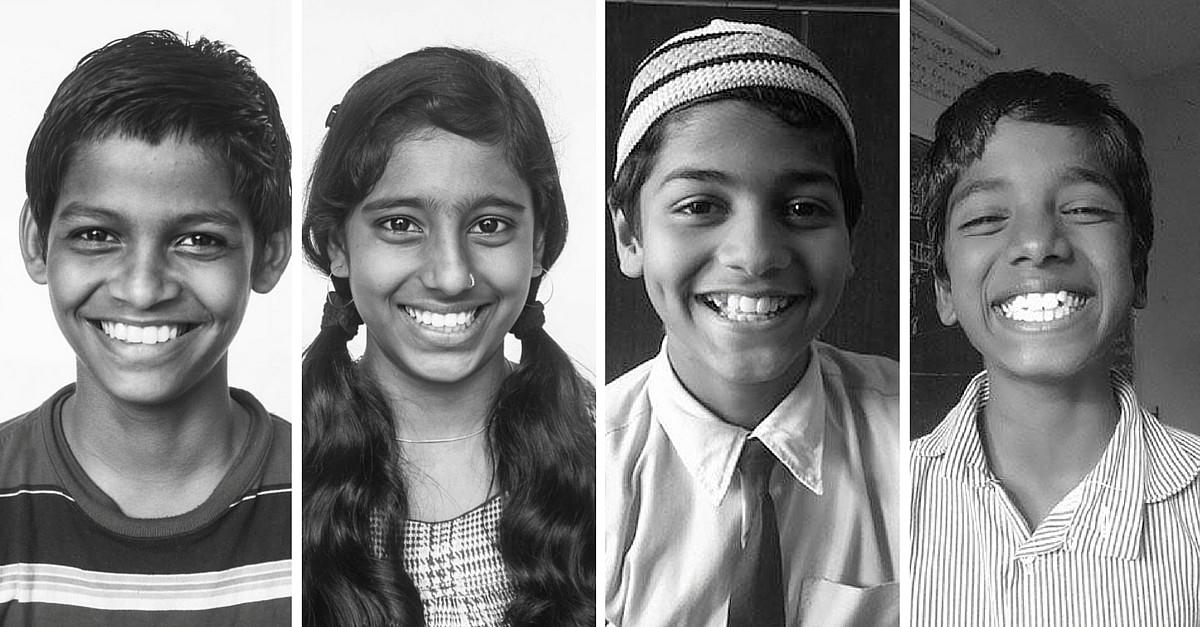
Target Audience- Young Adolescents (12-15 yr.)
- Impressionable due to hormonal, cognitive, behavioral changes
- Time in life right before major decision-making
- Have some exposure to gender-related issues
Information Architecture for Katti Batti
Image
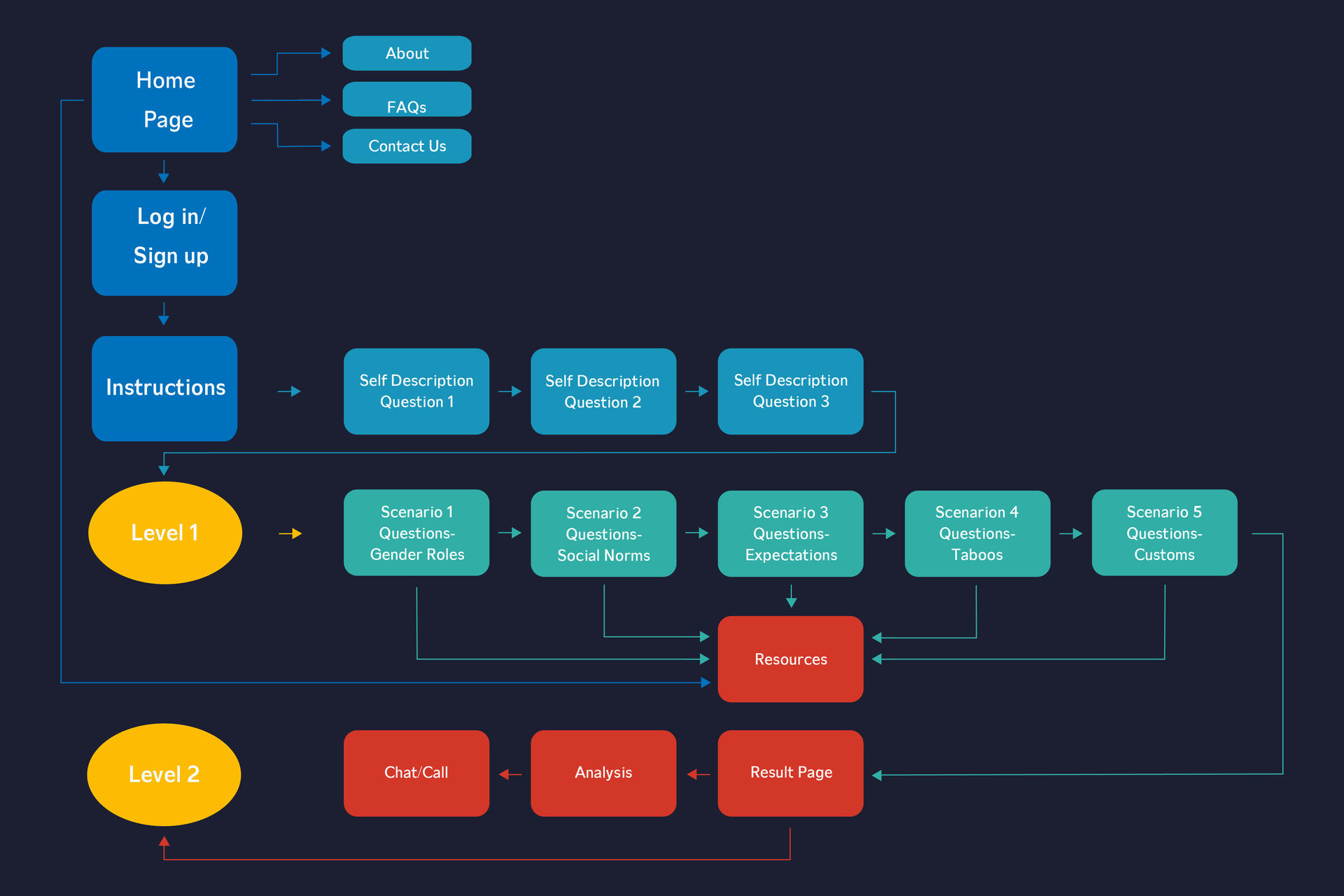
Image
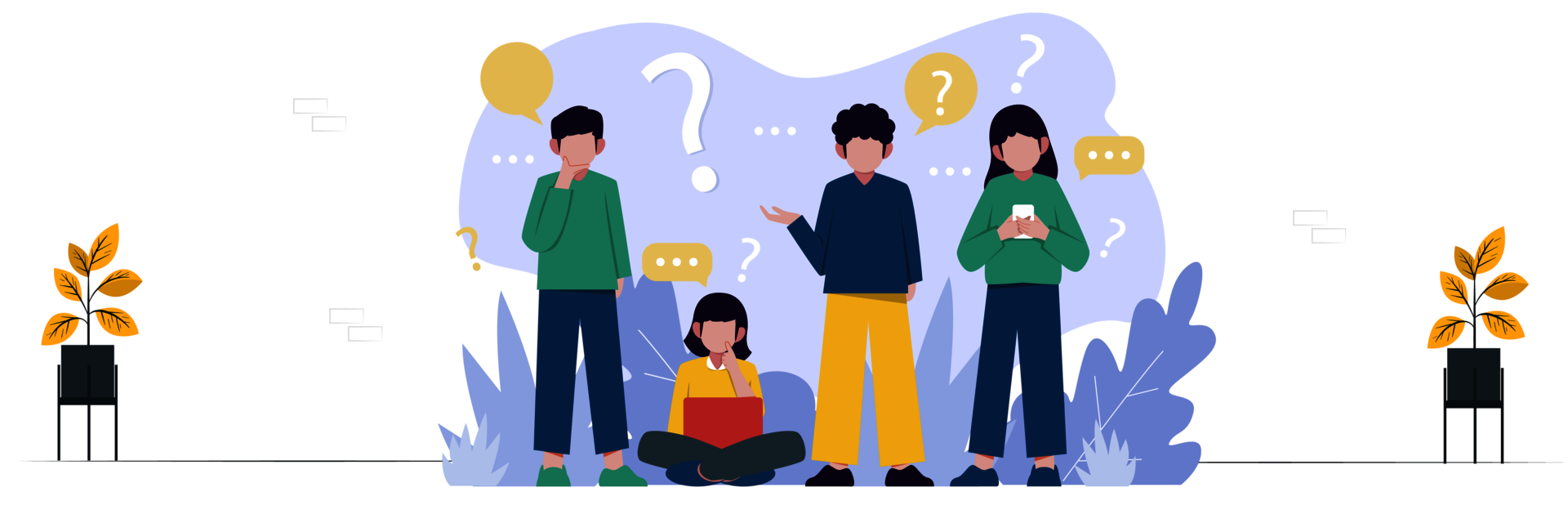
Katti-Batti: The Online Tool
A popular, innocent phrase among Indian kids to say I 'friend' you or I 'unfriend' you.
Katti- Unfriending, Batti- Friending
Image

Home Page with Slogan
Log In Page
Image
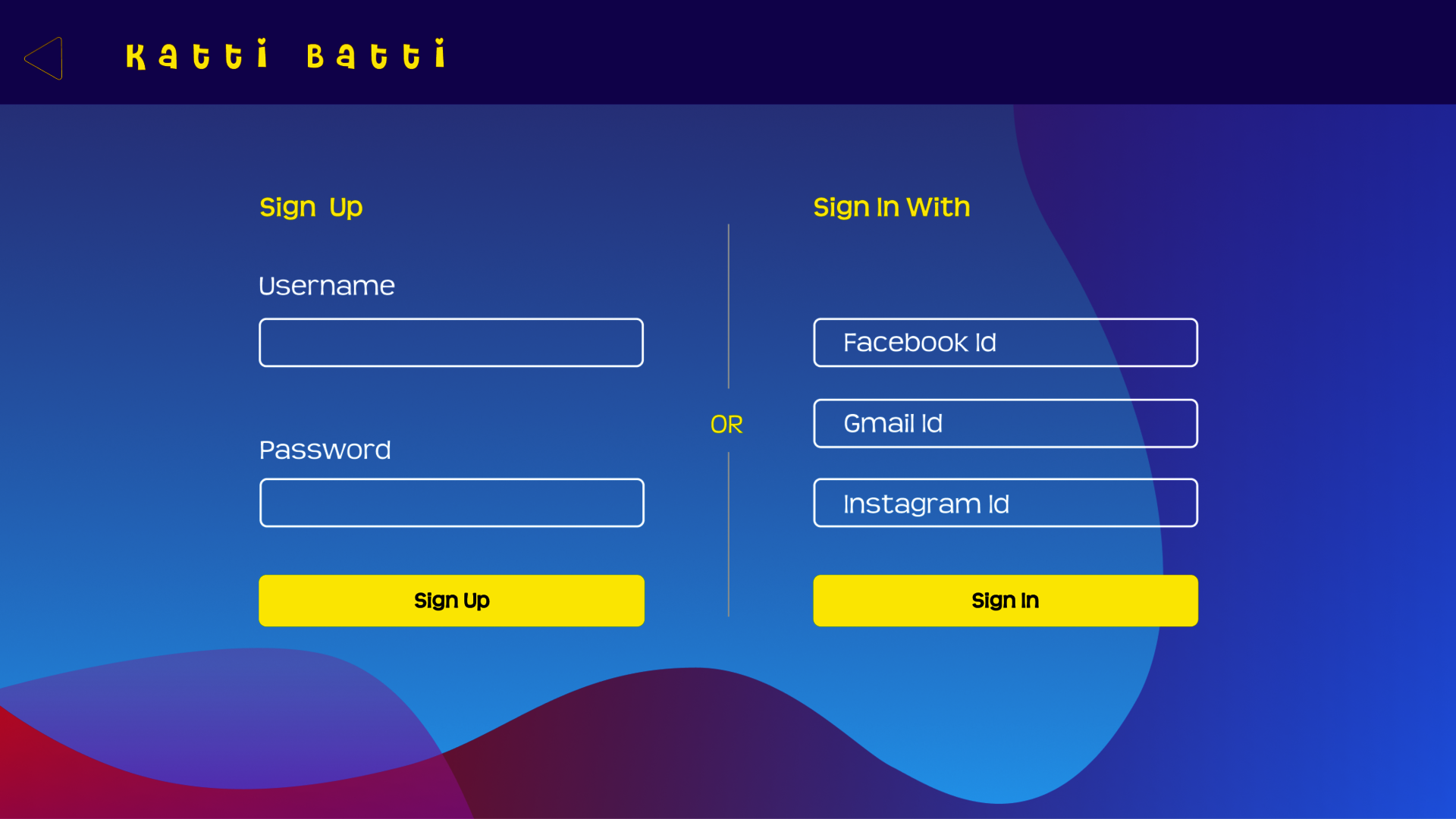
Image
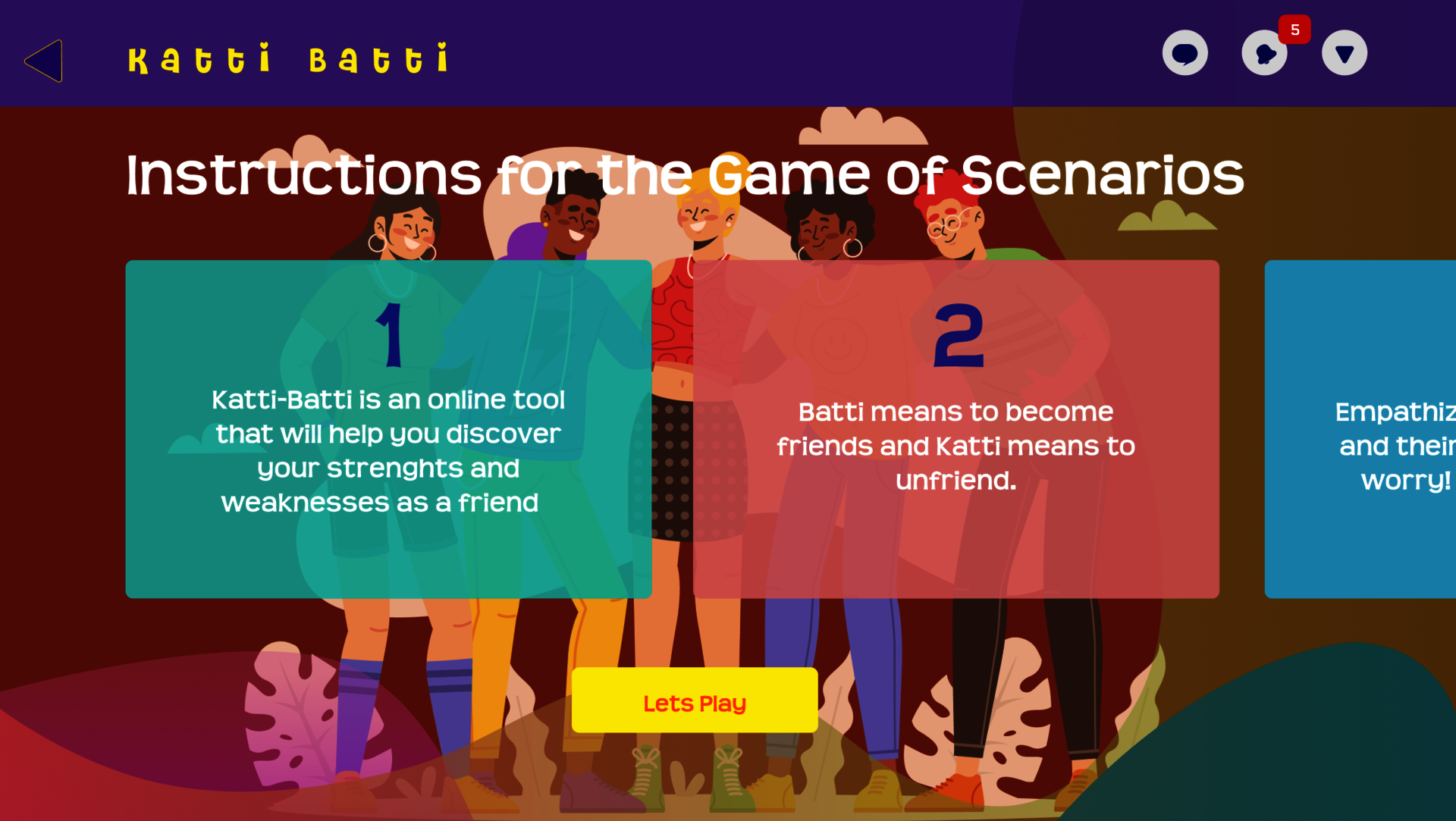
Instructions Page
Describe Yourself- Main Question 1
- This question serves a dual purpose, to help the audience reflect upon themselves and help them warm up. This question has qualities both traditionally, stereotypically ‘Masculine’ and ‘Feminine’. It is supposed to begin a slight conflict in the audience about what they think they are versus what they feel they should be.
- This question is adopted from an advocacy tool developed by Dr. Nandini Diwan, Retired Associate professor, and Head, Department of Psychology, D. G. Ruparel College, Mumbai; with due permission.
Image
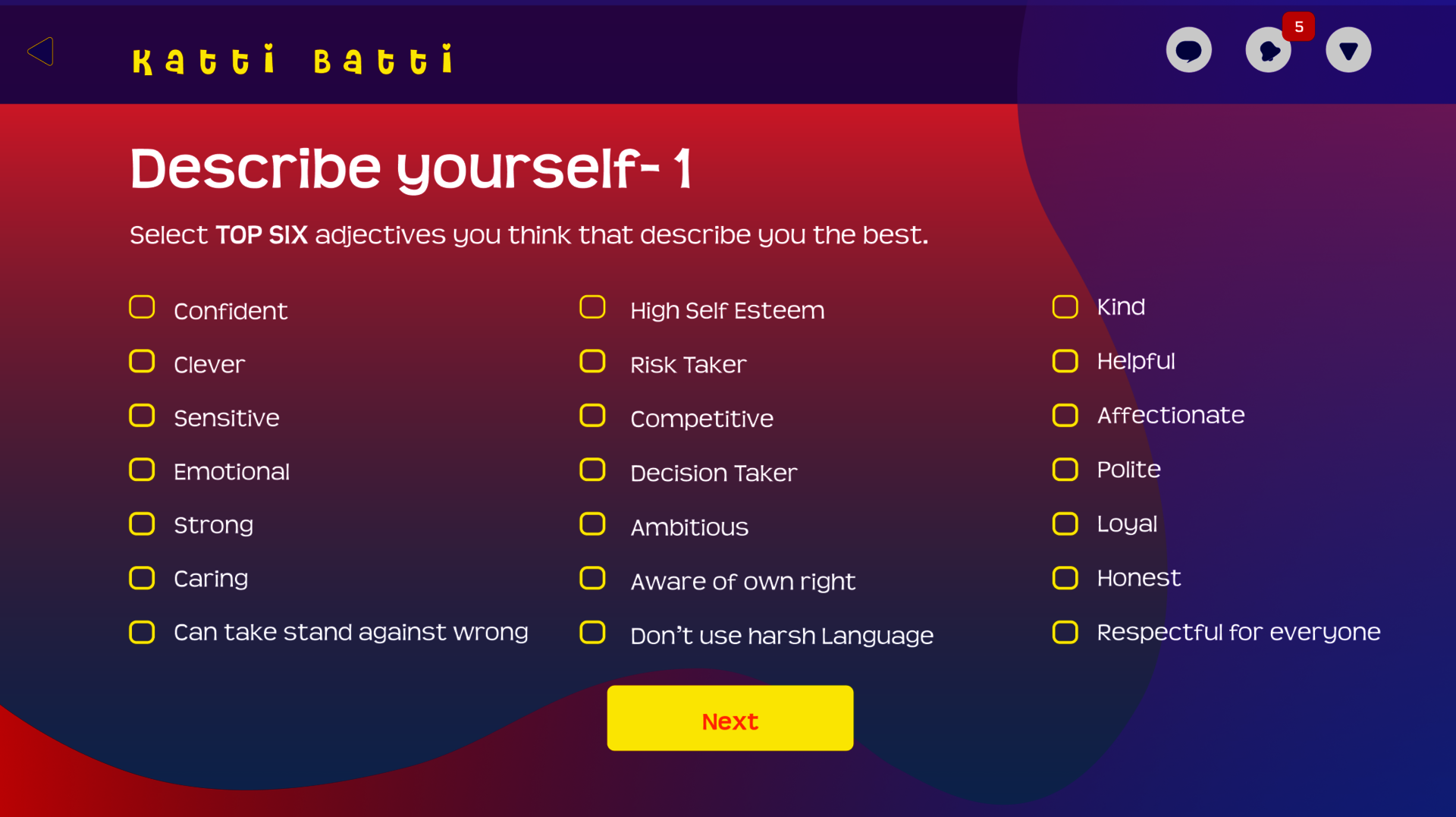
Image
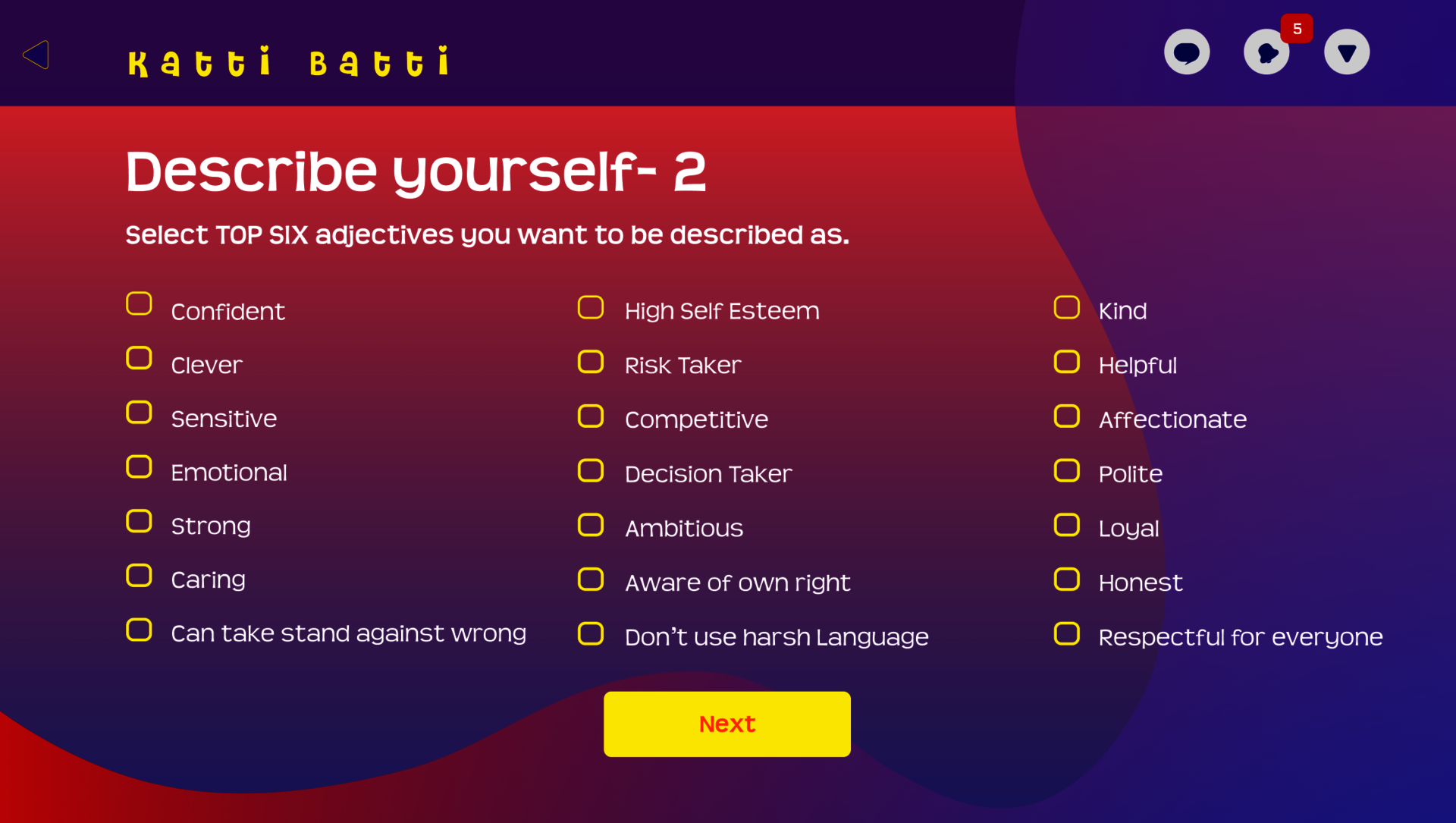
Describe Yourself- Main Question 2
- This question is meant to further ease the audience into the tool but at the same time think further about what qualities and emotions matter in relationships.
Describe Yourself- Main Question 3
- This question is meant to help the audience think about the larger perspective of world peace to recognize the importance of achieving the balance of both kinds of qualities, with the scales tipping slightly towards traditionally ‘feminine’ qualities.
Image
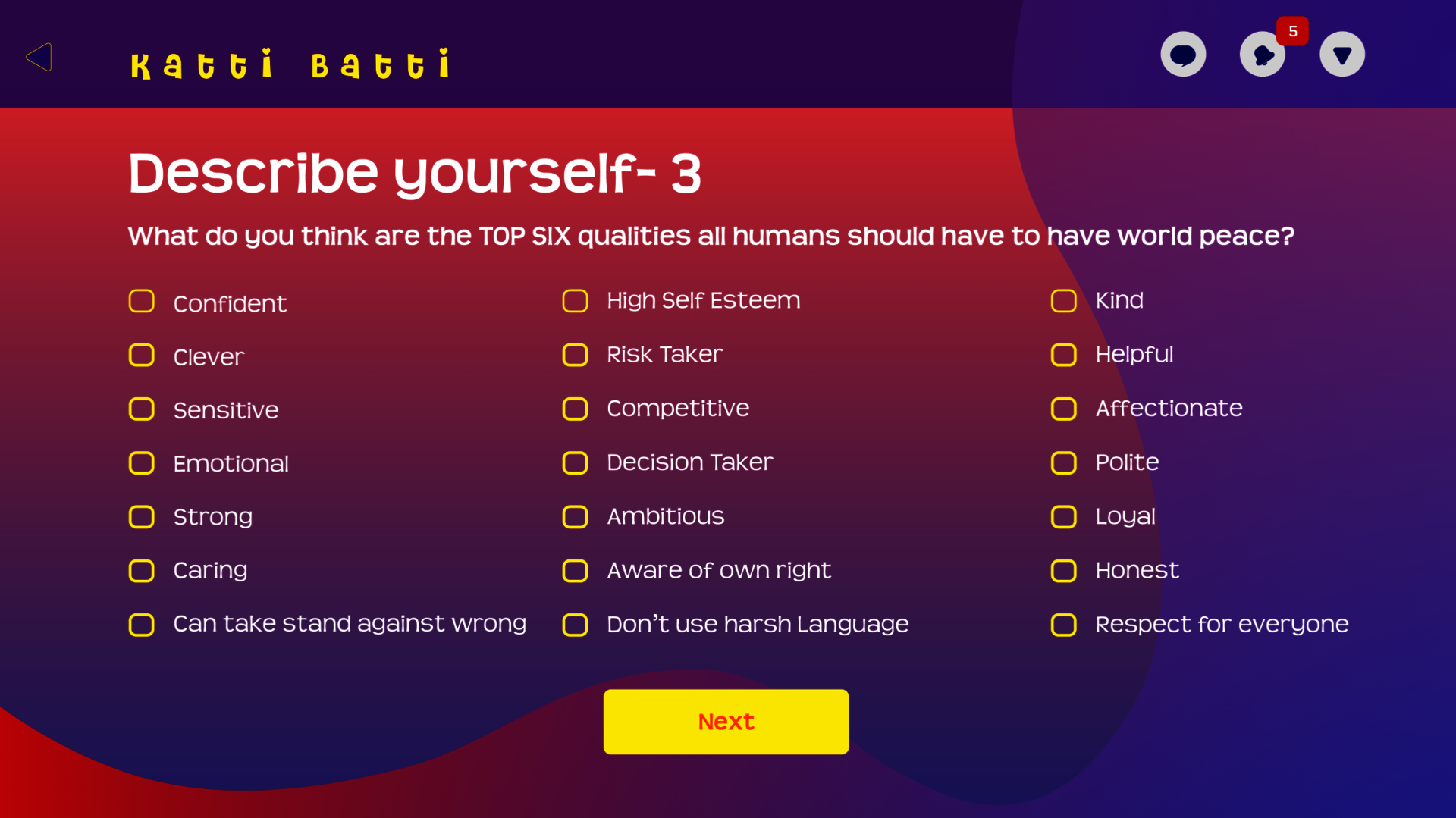
Image
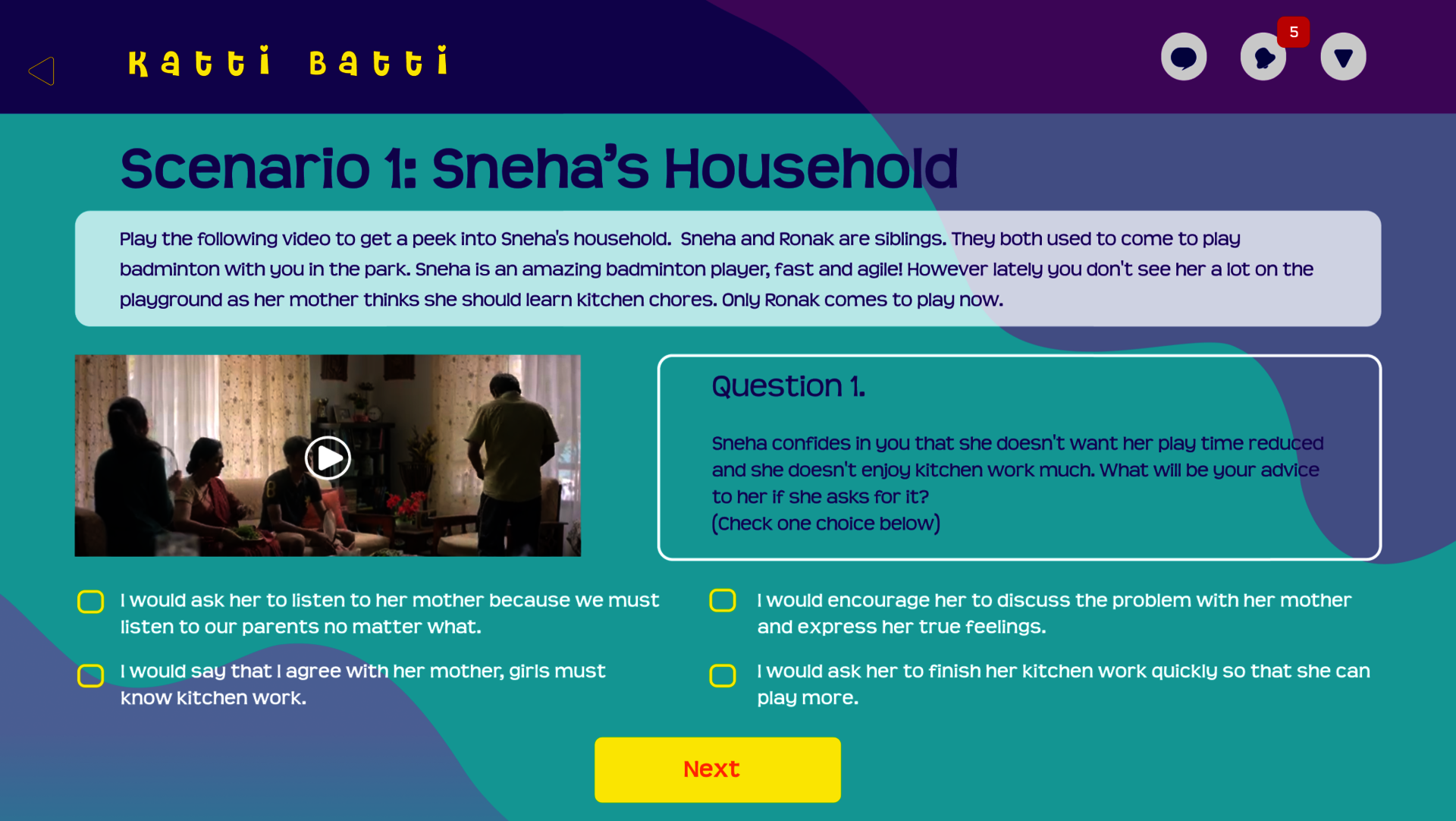
Scenario-Questions-Choices-1, Q1: Gender Roles
- The questions now venture into the various scenarios that are relatable to the Indian audience.
- These questions are intended to give the audience a glimpse of a character’s life through a video that could be an advertisement, movie clip, real-life pictures, memes, etc., usually from popular culture. The idea is to help the audience empathize with the characters. In this scenario, the video is from an Indian advertisement where a mother asks only her daughter to learn kitchen work and not the son.
- Following the media, there is a short written context that further helps to set a question up with the connotations of gender-related issues. In this scenario, the context molds the gist of the ad to a situation that asks the audience to imagine the girl character in the video to be their friend, who doesn’t enjoy kitchen work.
- There could be one or multiple questions on the same scenario to cover multiple dimensions of the issue of gender roles presented here. In this scenario, two questions are asked, to advise the character as a friend (question 1) and to imagine the role reversal of the parents and whether they would be fine if that happened in their lives (question 2).
- The choices or options provided to these questions are supposed to evoke thought on the issue. Various methods of inputting the choices are explored like multiple choice answers, ranking, sliders, etc.
- The choices are based on the three pillars of friendship introduced initially, i.e., acceptance, respect and care. The other options portray indifference or conformity to traditional, suppressing gender roles, norms, expectations, taboos, values, etc.
- The choices which portray acceptance of the personal wishes of the characters by the audience are scored the highest, and the ones which portray either indifference or conformity to traditional stereotypes are scored progressively lesser. For example, in question 1, option c gets 3 points, option a gets 1 point, and all other alternatives get a 0.
- A lot more work is needed on curating and molding the content, scenarios, contexts, and choices. Further, some focussed research is also needed to develop a systematic grading scale. However, to test the concept quickly, a rough, intuitive marking scheme was adopted. After the audience picks an answer, links to resources on gender roles open for further information and awareness.
Scenario-Questions-Choices-1, Q 2: Gender Roles
- Second question on the theme- gender roles.
- Option choice 'Would be fine' gets 3 points, slider in the middle gets 1 point, option choice 'Would be weird' gets 0 points.
Image
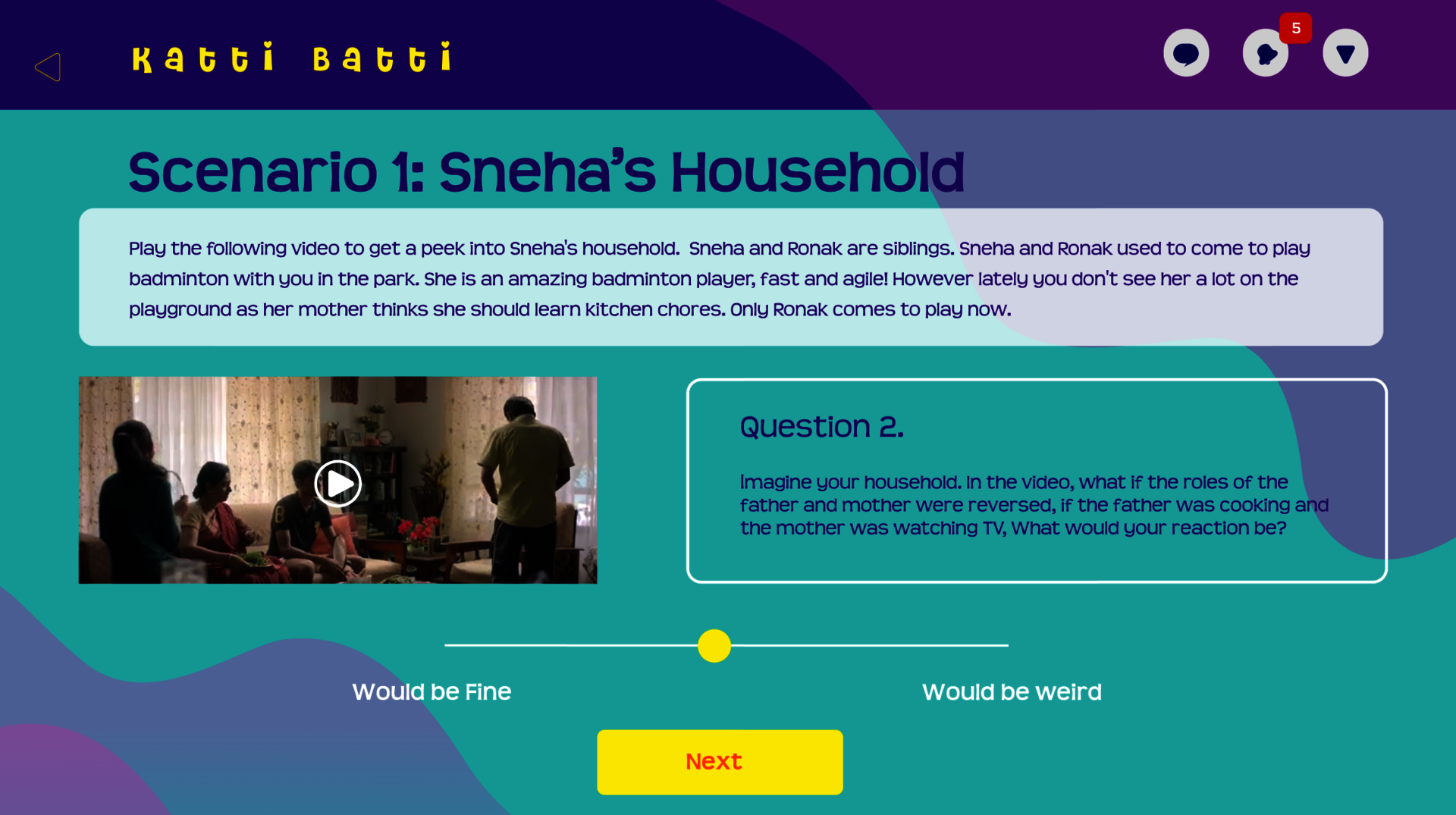
Image
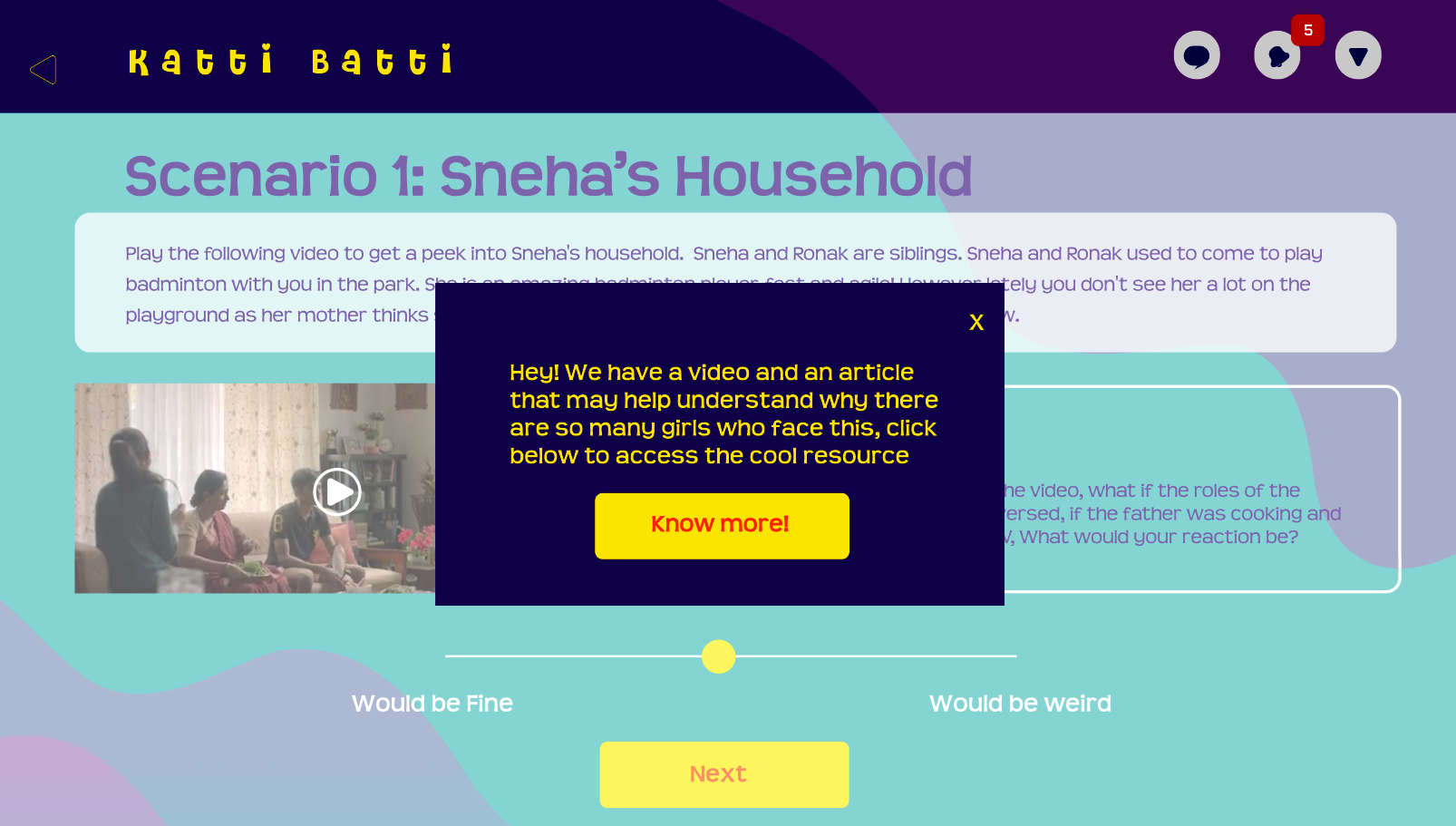
Resources Page Prompt
- After evoking through the scenario-question-choice approach, further resources are presented to the audiences while on the topic for further exploration.
Resources Page Prompt
Image
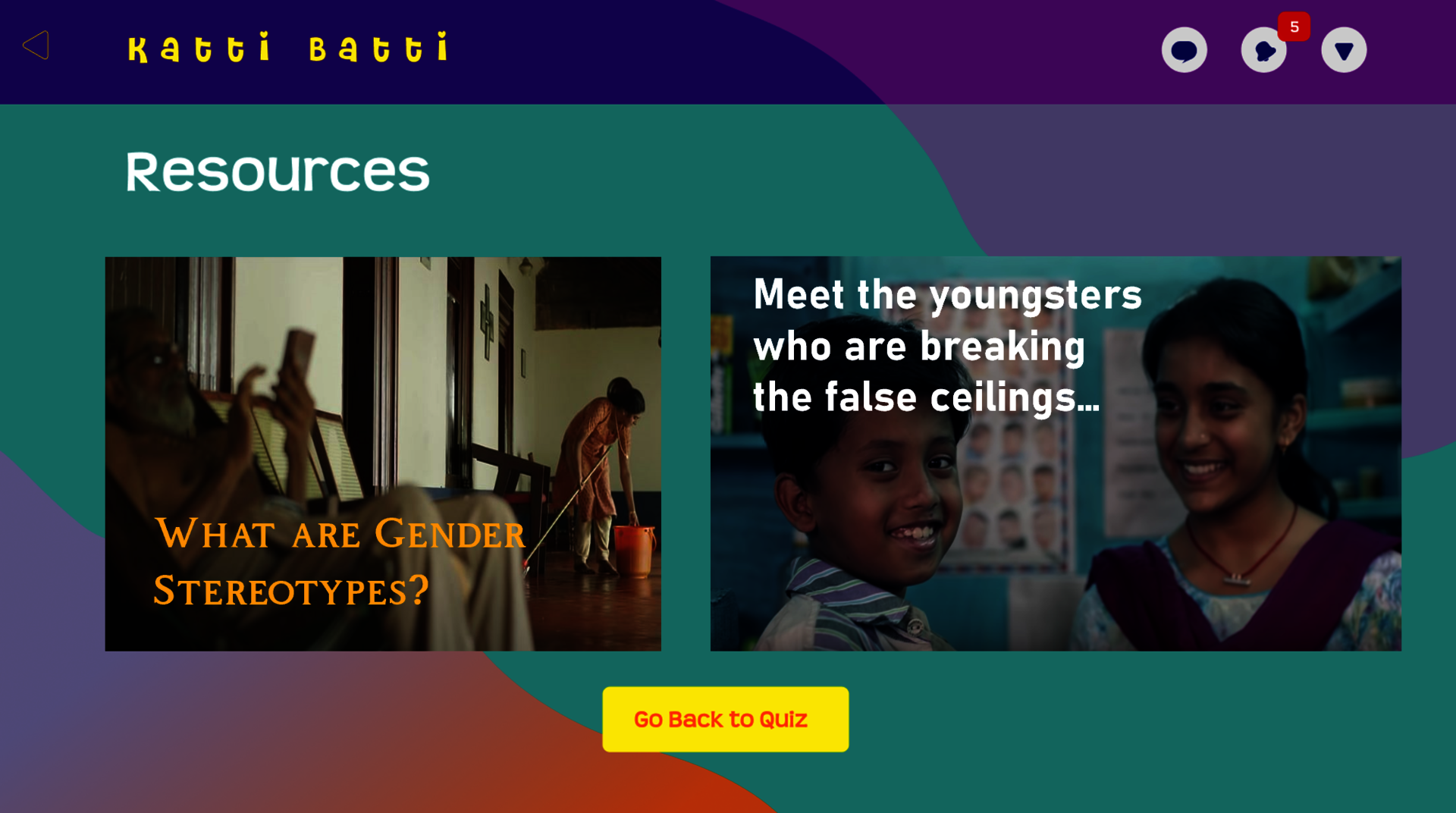
Image
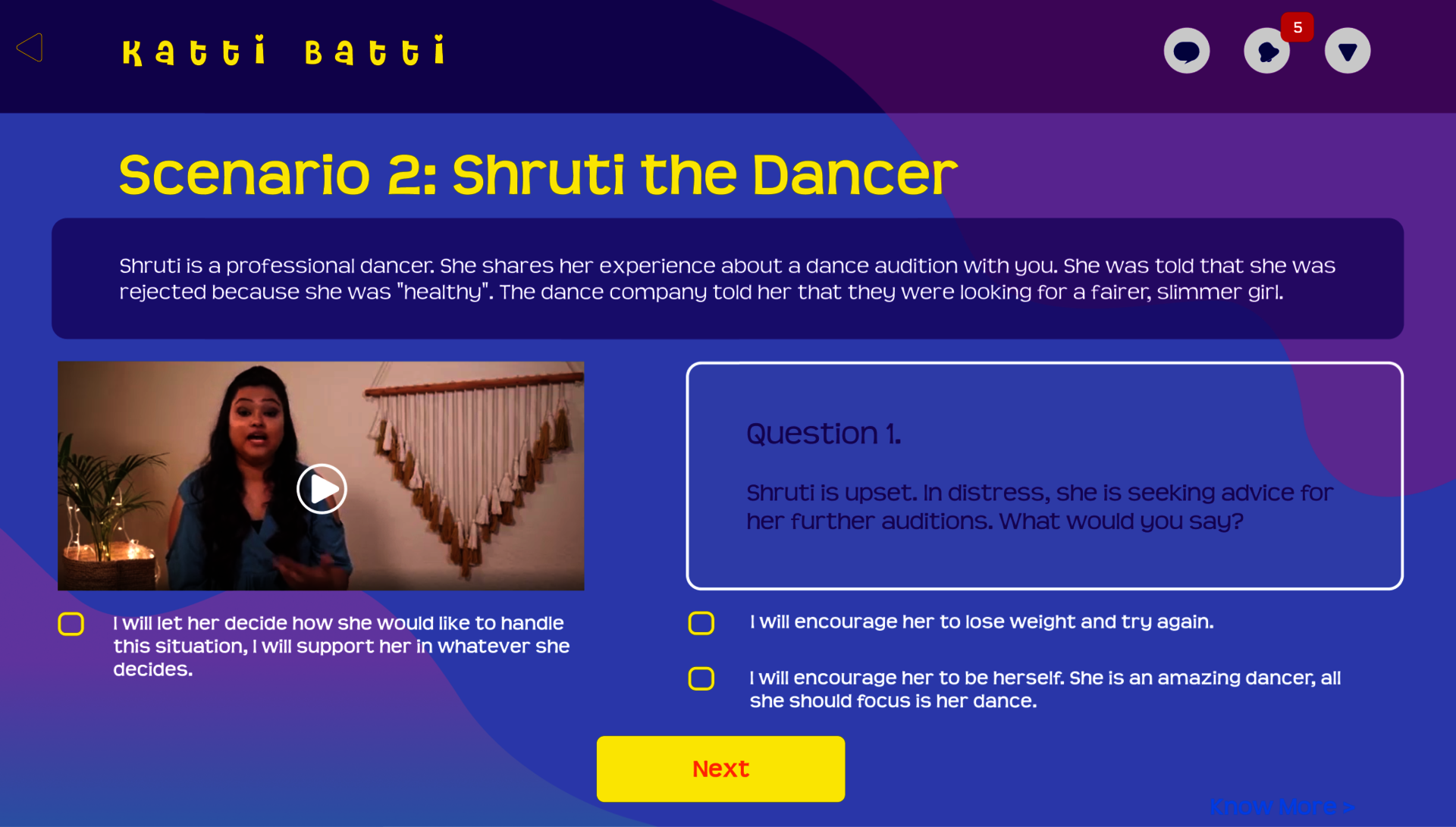
Scenario-Question-Choice 2, Q1- Gender Expectations
- Scenario-context-choices designed to evoke thought about the gendered
nature of expectations from people.
- For question 1, option 1 among choices receives 0 points, option 2 receives
1 point, and option 3 receives 3 points.
Scenario-Question-Choice 2, Q2- Gender Expectations
- Scenario-context-choices designed to evoke thought about the gendered nature of expectations from people.
- For question 2, option ‘Yes’ gets 0 points, and ‘No’ gets 3 points.
Image
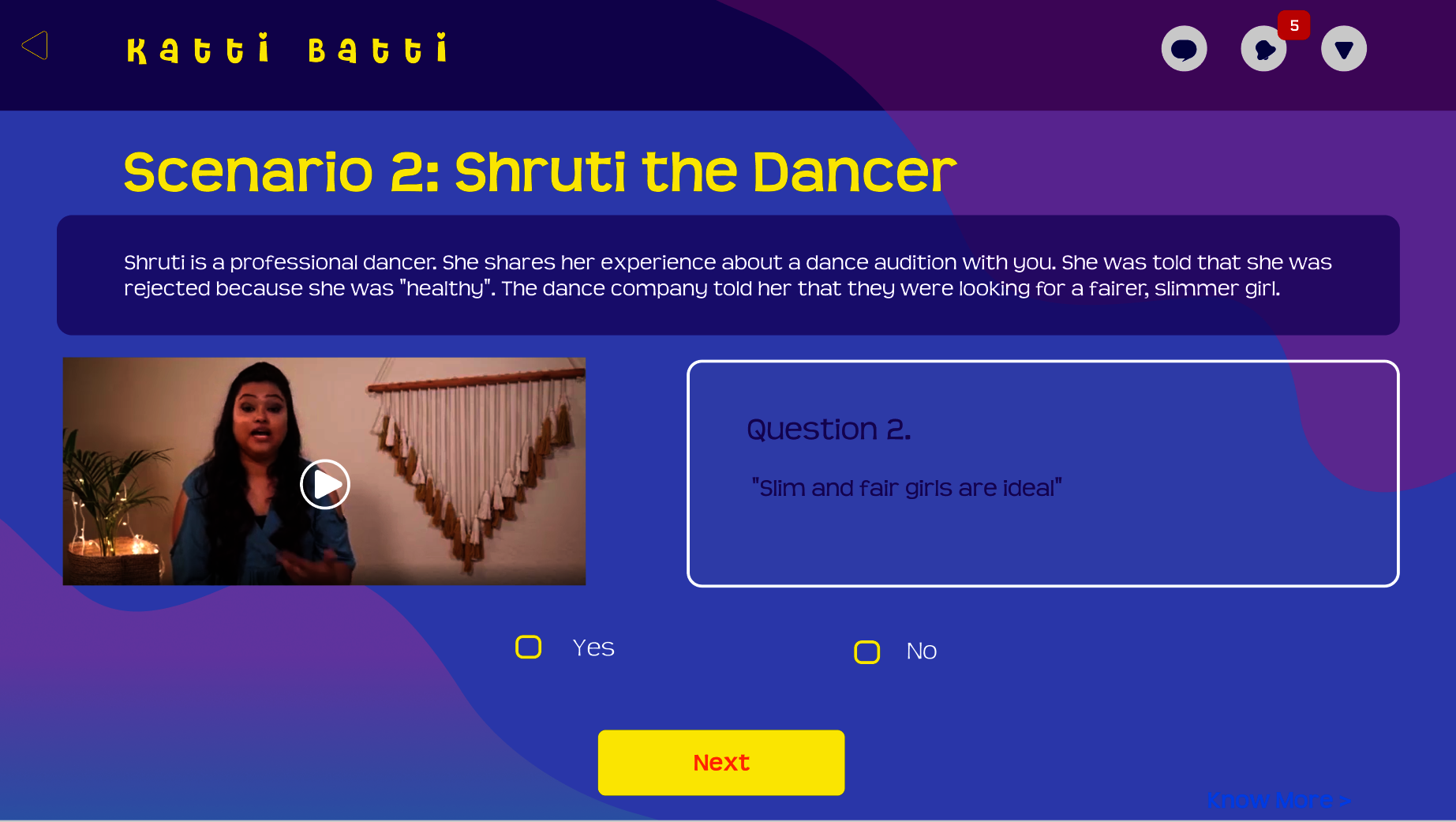
The audience will navigate through 8-10 scenarios, i.e., 20-30 questions on various topics like Gender Roles, Expectations, Norms, Taboos, Customs etc. derived from the hypothesis and also have the chance to view corresponding, age-appropriate literature designed by experts+designers for further information. The next step is receiving the results of the quiz.
Image
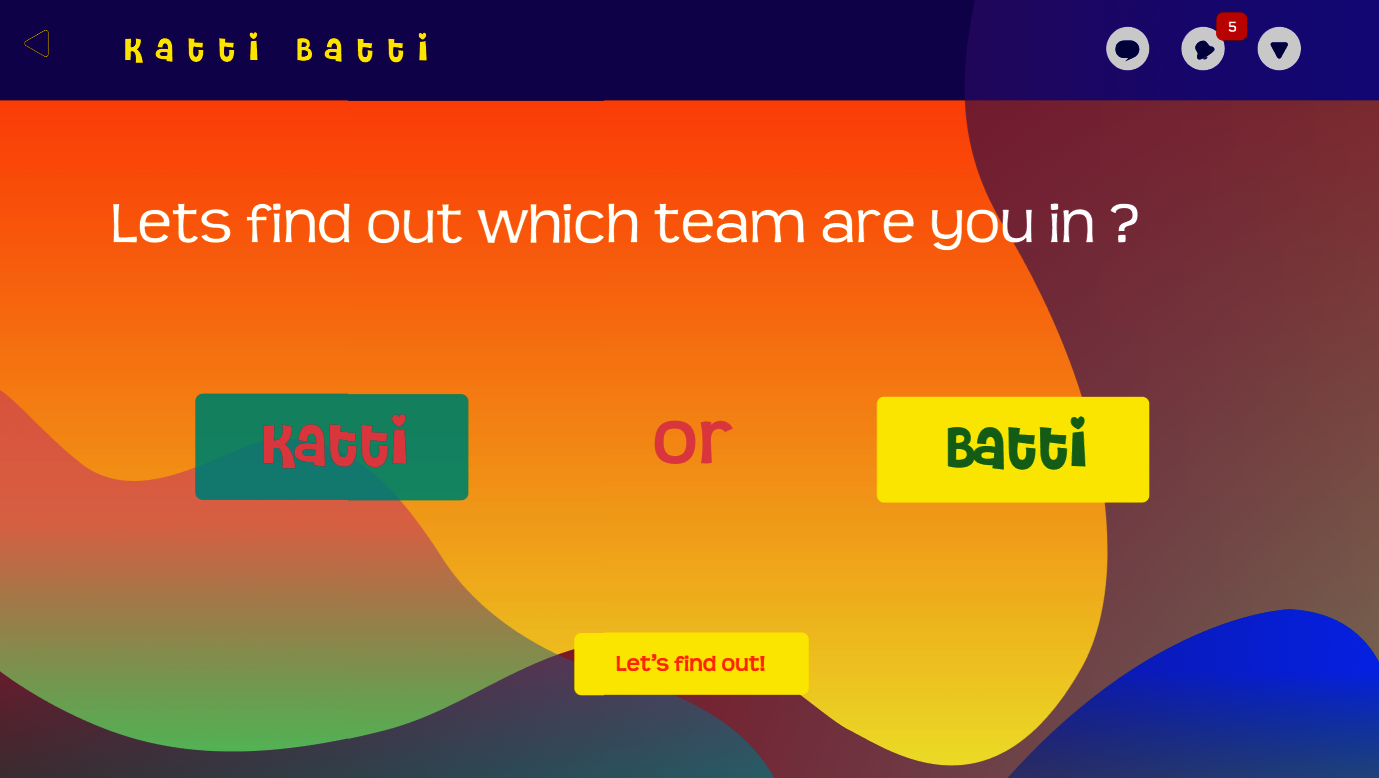
Quiz Result Page-1
Features to
- Share the results with friends
- Analyze results
- Check actual score
Quiz Result Page-2
Features to
- Share the results with friends
- Analyze results
- Check actual score
Image
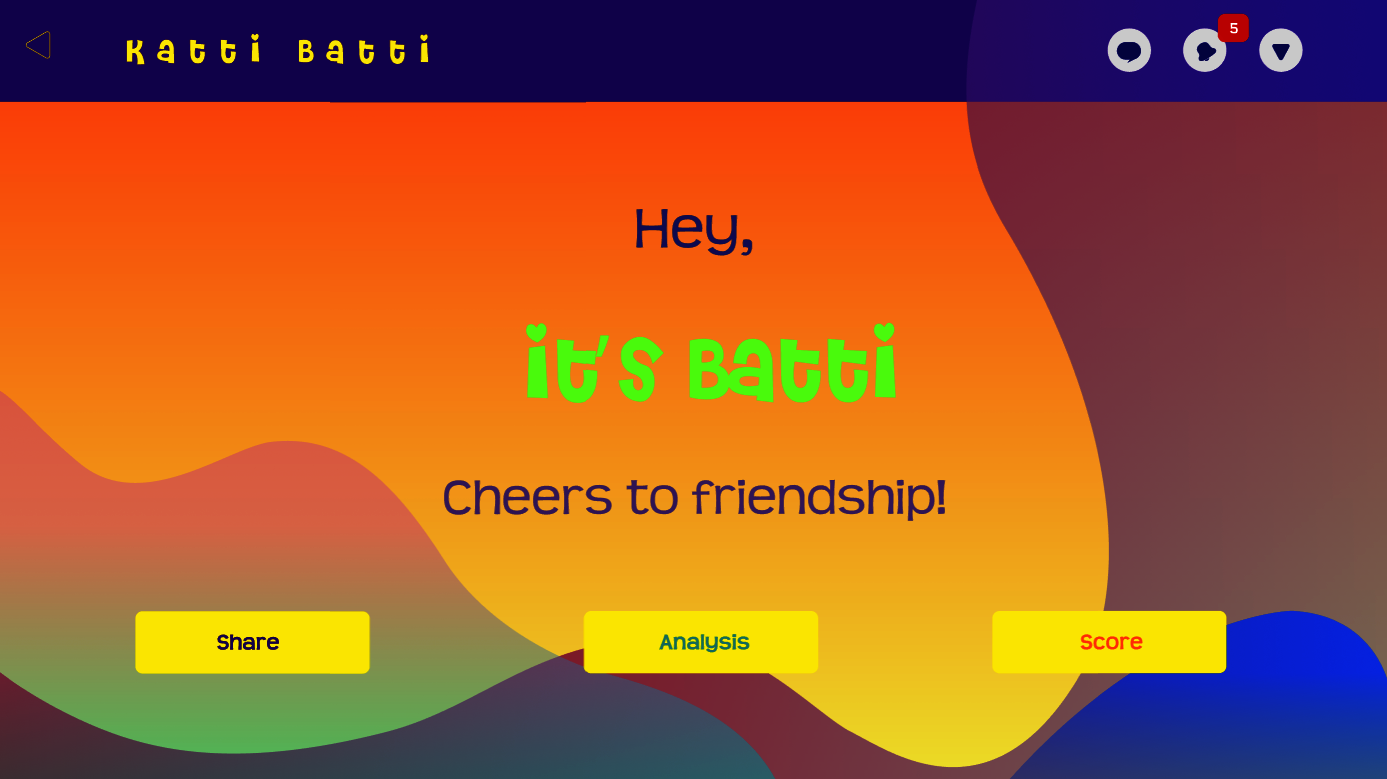
Image
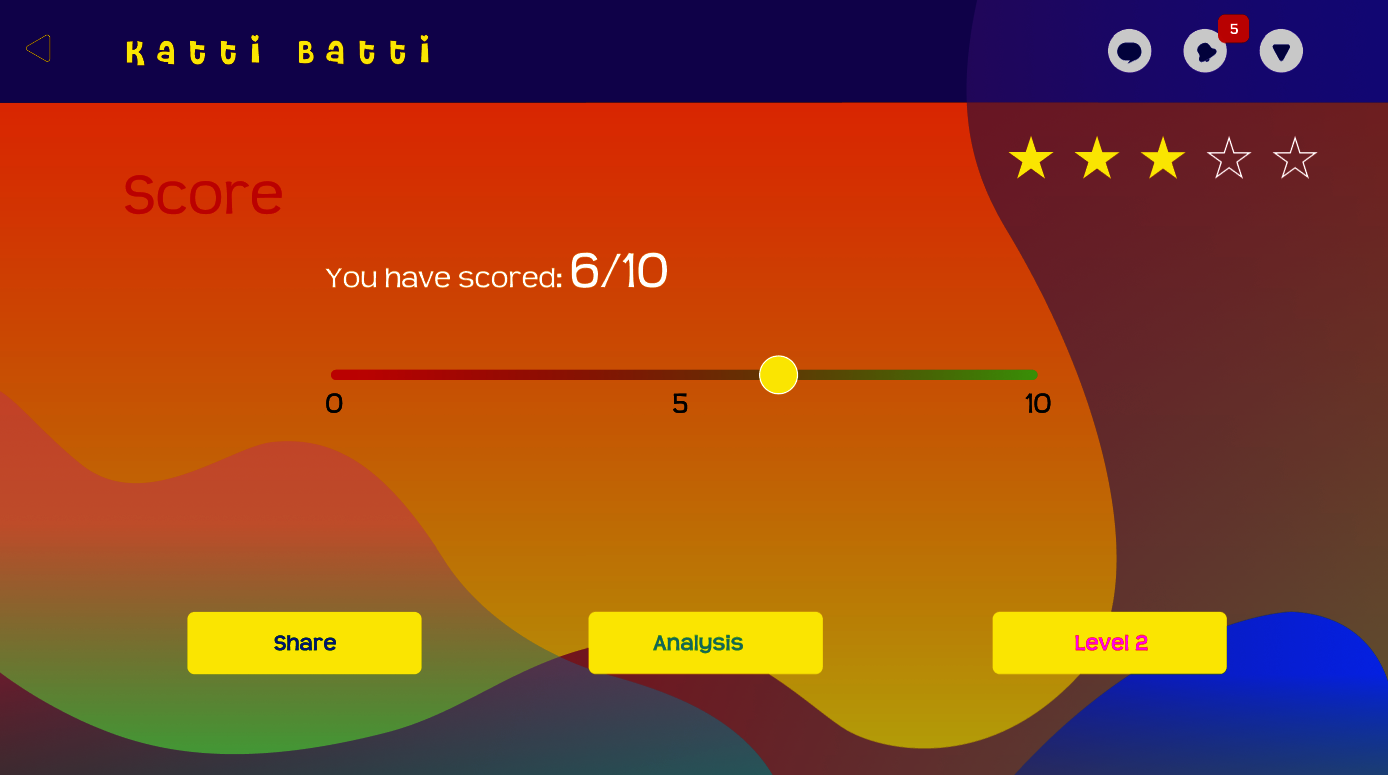
Quiz Score
Features to
- Share the results with friends
- Analyze results
- Go to level two if you score more than 6/10 (intentionally easy to score)
Analysis
Feature to
- Learn how the user scored on each scenario question by question with explanation (after clicking on “click here to know more”)
Image
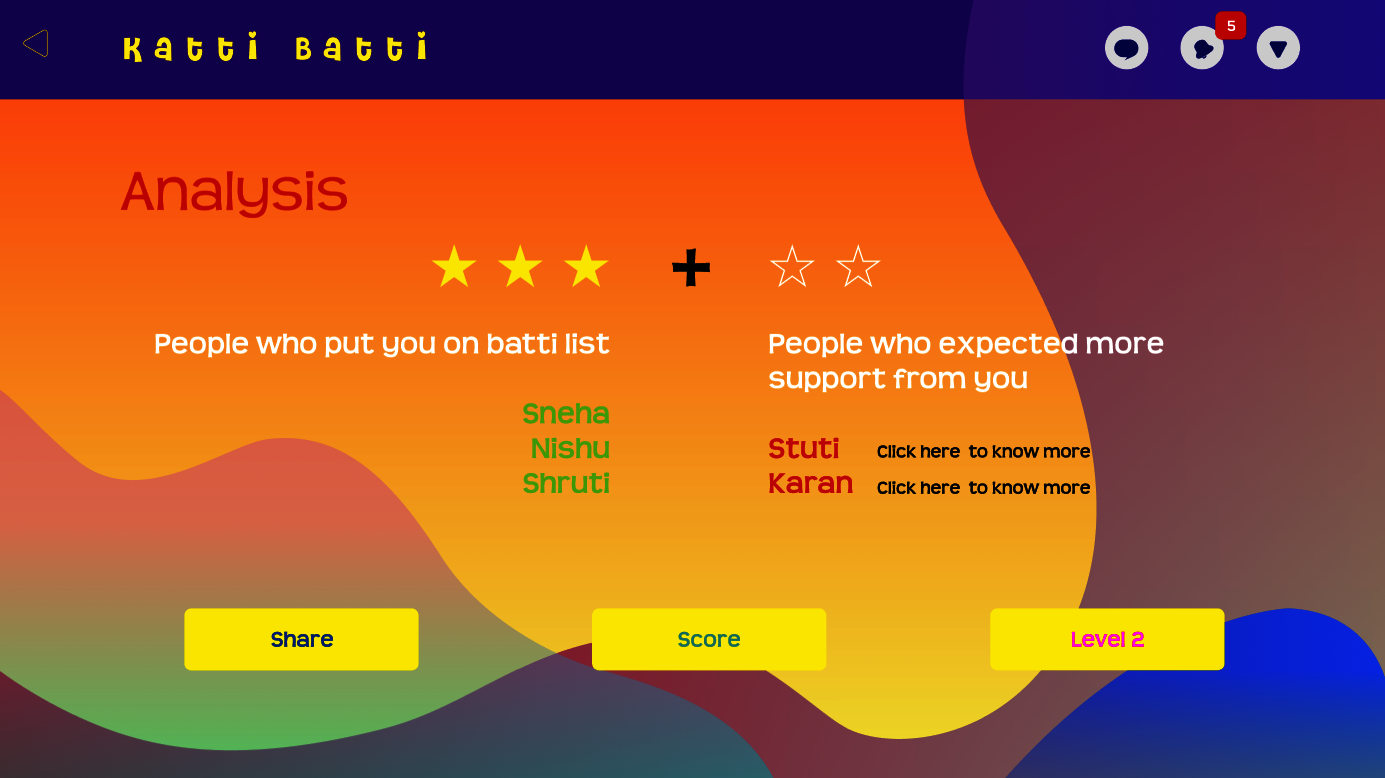
Image

“I learned that we should always put ourselves in other people’s shoes because
we never know what someone else is going through”- Srimoyee, 13
“I learned about new genders: non-binary, agender, gender-neutral,
genderqueer, and gender-fluid. I also learned more about people and their
experiences with gender discrimination”- Maanyata, 12
“I learned the importance of gender equality at the same time criticism
could take place in any form, thin or fat. I also understood that the society’s
mentality affects every individual”- Jashn, 12
Image

Image
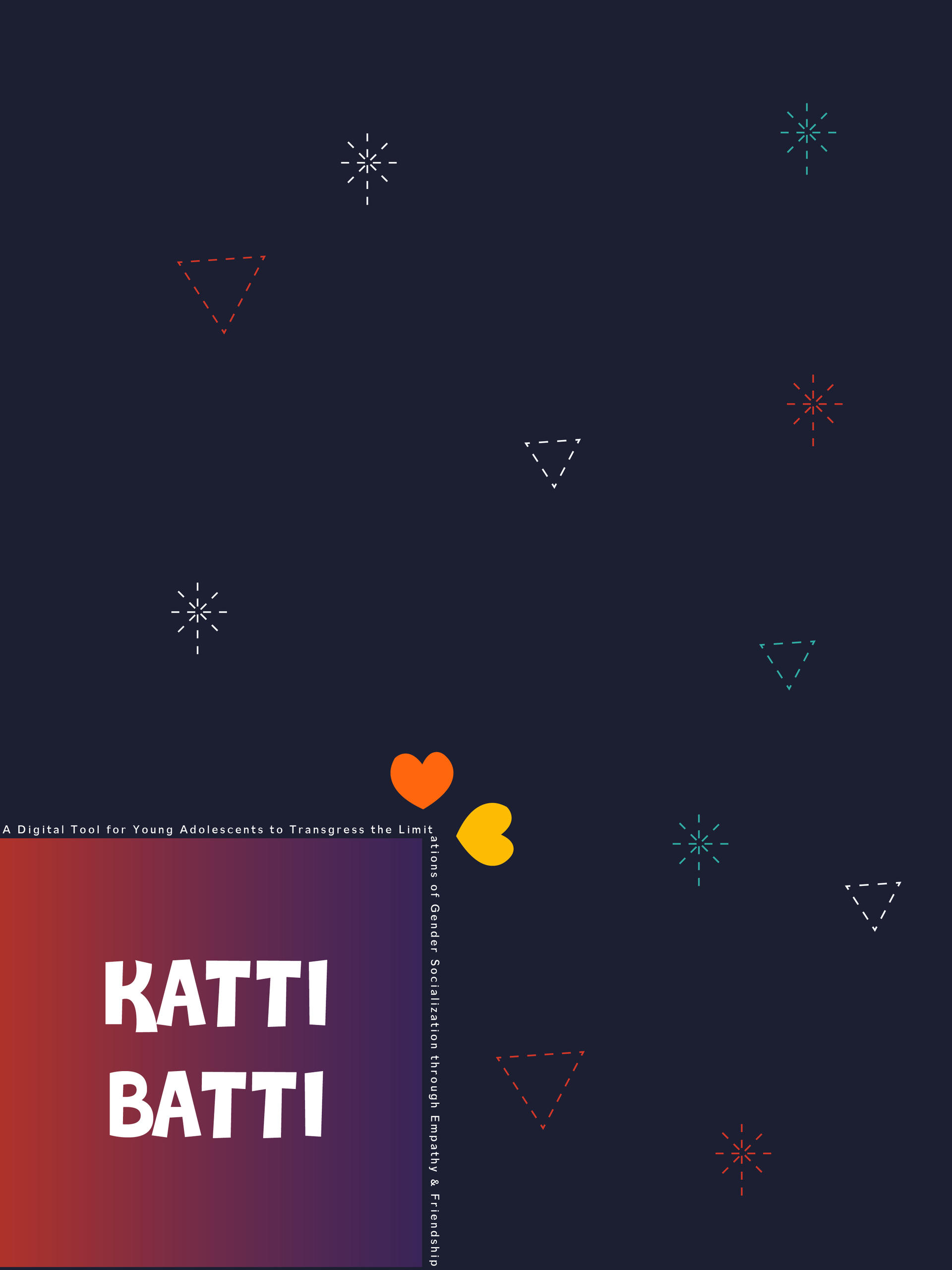
Image
